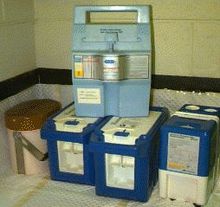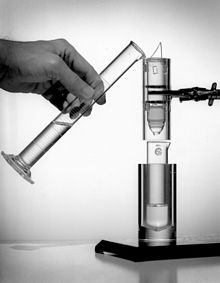Technetium-99m generator


A technetium-99m generator, or colloquially a technetium cow or moly cow, is a device used to extract the metastable isotope 99mTc of technetium from a decaying sample of molybdenum-99. 99Mo has a half-life of 66 hours[1] and can be easily transported over long distances to hospitals where its decay product technetium-99m (with a half-life of only 6 hours, inconvenient for transport) is extracted and used for a variety of nuclear medicine diagnostic procedures, where its short half-life is very useful.
Parent isotope source[edit]
99Mo can be obtained by the neutron activation (n,γ reaction) of 98Mo in a high-neutron-flux reactor. However, the most frequently used method is through fission of uranium-235 in a nuclear reactor. While most reactors currently engaged in 99Mo production use highly enriched uranium-235 targets, proliferation concerns have prompted some producers to transition to low-enriched uranium targets.[2] The target is irradiated with neutrons to form 99Mo as a fission product (with 6.1% yield).[3] Molybdenum-99 is then separated from unreacted uranium and other fission products in a hot cell.[4]
Generator invention and history[edit]
99mTc remained a scientific curiosity until the 1950s when Powell Richards realized the potential of technetium-99m as a medical radiotracer and promoted its use among the medical community.[5] While Richards was in charge of the radioisotope production at the Hot Lab Division of the Brookhaven National Laboratory, Walter Tucker and Margaret Greene were working on how to improve the separation process purity of the short-lived eluted daughter product iodine-132 from tellurium-132, its 3.2-days parent, produced in the Brookhaven Graphite Research Reactor.[6] They detected a trace contaminant which proved to be 99mTc, which was coming from 99Mo and was following tellurium in the chemistry of the separation process for other fission products. Based on the similarities between the chemistry of the tellurium-iodine parent-daughter pair, Tucker and Greene developed the first technetium-99m generator in 1958.[7][8] It was not until 1960 that Richards became the first to suggest the idea of using technetium as a medical tracer.[9][10][11][12]
Generator function and mechanism[edit]
Technetium-99m's short half-life of 6 hours makes long-term storage impossible. Transport of 99mTc from the limited number of production sites to radiopharmacies (for manufacture of specific radiopharmaceuticals) and other end users would be complicated by the need to significantly overproduce to have sufficient remaining activity after long journeys. Instead, the longer-lived parent nuclide 99Mo can be supplied to radiophamacies in a generator, after its extraction from the neutron-irradiated uranium targets and its purification in dedicated processing facilities.[13] Radiopharmacies may be hospital-based or stand-alone facilities, and in many cases will subsequently distribute 99mTc radiopharmaceuticals to regional nuclear medicine departments. Development in direct production of 99mTc, without first producing the parent 99Mo, precludes the use of generators; however, this is uncommon and relies on suitable production facilities close to radiopharmacies.[14]
Production[edit]
Generators provide radiation shielding for transport and to minimize the extraction work done at the medical facility. A typical dose rate at 1 metre from 99mTc generator is 20–50 μSv/h during transport.[15]
These generators' output declines with time and must be replaced weekly, since the half-life of 99Mo is still only 66 hours. Since the half-life of the parent nuclide (99Mo) is much longer than that of the daughter nuclide (99mTc), 50% of equilibrium activity is reached within one daughter half-life, 75% within two daughter half-lives. Hence, removing the daughter nuclide (elution process) from the generator ("milking" the cow) is reasonably done as often as every 6 hours in a 99Mo/99mTc generator.[16]
Separation[edit]
Most commercial 99Mo/99mTc generators use column chromatography, in which 99Mo in the form of molybdate, MoO42− is adsorbed onto acid alumina (Al2O3). When the Mo-99 decays it forms pertechnetate TcO4−, which, because of its single charge, is less tightly bound to the alumina. Pouring normal saline solution through the column of immobilized 99Mo elutes the soluble 99mTc, resulting in a saline solution containing the 99mTc as pertechnetate, with sodium as the counterion.
The solution of sodium pertechnetate may then be added in an appropriate concentration to the pharmaceutical kit to be used, or sodium pertechnetate can be used directly without pharmaceutical tagging for specific procedures requiring only the 99mTcO4− as the primary radiopharmaceutical. A large percentage of the 99mTc generated by a 99Mo/99mTc generator is produced in the first 3 parent half-lives, or approximately one week. Hence, clinical nuclear medicine units purchase at least one such generator per week or order several in a staggered fashion.[17]
Isomeric ratio[edit]
When the generator is left unused, 99Mo decays to 99mTc, which in turn decays to 99Tc. The half-life of 99Tc is far longer than its metastable isomer, so the ratio of 99Tc to 99mTc increases over time. Both isomers are carried out by the elution process and react equally well with the ligand, but the 99Tc is an impurity useless to imaging (and cannot be separated).
The generator is washed of 99Tc and 99mTc at the end of the manufacturing process of the generator, but the ratio of 99Tc to 99mTc then builds up again during transport or any other period when the generator is left unused. The first few elutions will have reduced effectiveness because of this high ratio.[18]
References[edit]
- ^ R. Nave. "Technetium-99m". HyperPhysics. Georgia State University.
- ^ The National Research Council. Medical Isotope Production Without Highly Enriched Uranium (Report). Retrieved 20 November 2012.
- ^ "Archived copy" (PDF). Archived from the original (PDF) on 24 May 2009. Retrieved 2 August 2008.
{{cite web}}: CS1 maint: archived copy as title (link) - ^ Snelgrove L, Hofman GL, Wiencek TC, Wu CT, Vandegrift GF, Aase S, Buchholz BA, Dong DJ, Leonard RA, Srinivasan B (18–21 September 1994). Development and Processing Of LEU Targets for Mo-99 Production—Overview of the ANL Program. 1995 International Meeting on Reduced Enrichment for Research and Test Reactors. Paris. OSTI 146775.
- ^ Gasparini, Allison (24 October 2018). "Celebrating the 60th Anniversary of Technetium-99m". Brookhaven National Laboratory.
- ^ "Brookhaven Graphite Research Reactor". bnl.gov. Archived from the original on 2 April 2013. Retrieved 3 May 2012.
- ^ Richards, Powell (1989). Technetium-99m: The Early Days. Vol. BNL-43197 CONF-8909193-1. New York: Brookhaven National Laboratory. OSTI 5612212.
- ^ Tucker, W.D.; Greene, M.W.; Weiss, A.J.; Murrenhoff, A. (1958). "Methods of preparation of some carrier-free radioisotopes involving sorption on alumina". Transactions American Nuclear Society. 1: 160–161.
- ^ Richards, Powell (1960). "A survey of the production at Brookhaven National Laboratory of radioisotopes for medical research". VII Rassegna Internazionale Elettronica e Nucleare Roma: 223–244.
- ^ "The Technetium-99m Generator". Bnl.gov. Archived from the original on 2 April 2013.
- ^ Richards, P.; Tucker, W.D.; Srivastava, S.C. (October 1982). "Technetium-99m: an historical perspective". The International Journal of Applied Radiation and Isotopes. 33 (10): 793–9. doi:10.1016/0020-708X(82)90120-X. PMID 6759417.
- ^ Stang, Louis G.; Richards, Powell (1964). "Tailoring the isotope to the need". Nucleonics. 22 (1). ISSN 0096-6207.
- ^ Dilworth, Jonathan R.; Parrott, Suzanne J. (1998). "The biomedical chemistry of technetium and rhenium". Chemical Society Reviews. 27: 43–55. doi:10.1039/a827043z.
- ^ Boschi, Alessandra; Martini, Petra; Pasquali, Micol; Uccelli, Licia (2 September 2017). "Recent achievements in Tc-99m radiopharmaceutical direct production by medical cyclotrons". Drug Development and Industrial Pharmacy. 43 (9): 1402–1412. doi:10.1080/03639045.2017.1323911. PMID 28443689. S2CID 21121327.
- ^ Shaw, Ken B. (Spring 1985). "Worker Exposures: How Much in the UK?" (PDF). IAEA Bulletin. Archived from the original (PDF) on 5 September 2011. Retrieved 19 May 2012.
- ^ Brant, William E.; Helms, Clyde (2012). Fundamentals of Diagnostic Radiology. Lippincott Williams & Wilkins. p. 1240. ISBN 9781451171396.
- ^ Hamilton, David I. (2004). Diagnostic Nuclear Medicine: A Physics Perspective. Springer Science & Business Media. p. 28. ISBN 9783540006909.
- ^ Moore, P.W. (April 1984). "Technetium-99 in generator systems" (PDF). Journal of Nuclear Medicine. 25 (4): 499–502. PMID 6100549. Retrieved 11 May 2012.
